Day Eleven – Geothermo
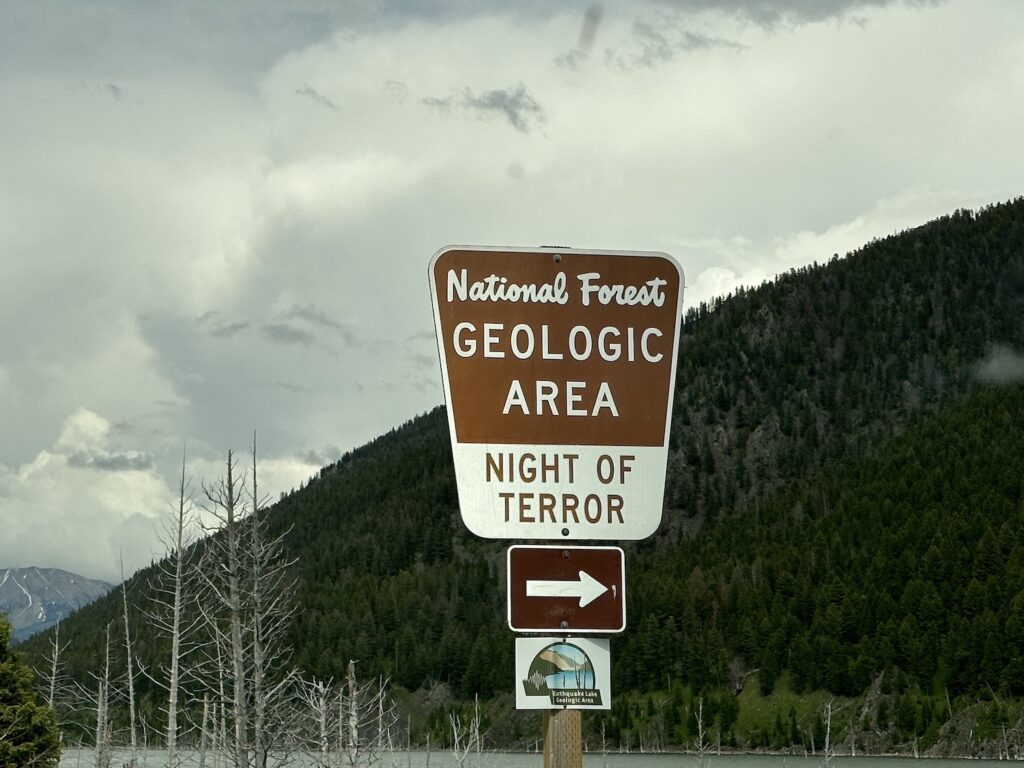
Our first (and only) unapologetically tourist day. Staying outside of West Yellowstone makes this easy as the town, while not a full-on tourist trap, is the cheeseball flag-waving souvenir capital of the park. So we embraced it for the day and headed out with a centerpiece destination of Old Faithful, surrounded by other geological sites both famous and WTF.
But first, of course, we watched the destruction of Yellowstone scene from 2012 to set the mood. Let me note here that this trip (and many before) has been made so much more fun with the use of the newly-renamed GuideAlong. It’s a non-linear, location-based, vehicle-centric audio guide for national parks and other scenic drives. Completely offline too, which is key in the connectivity deserts we’ve been in of late. And for the spaces in between the major destinations we use Autio to provide some insight into just what we’re passing through. Add in Roadside America and Atlas Obscura and there is no lack of information on bizarre Americana. (I’ll do a full post on all the gear, tech, and vehicle shenanigans when the trip is complete.)
We saw every aspect of the geothermal oddity that is the Yellowstone Supervolcano: boiling mud pools, hot and colorful mineral springs, and geysers to be sure. Old Faithful has changed a lot since I was there as a kid. The geyser still spews pretty consistently, but the infrastructure around it — yikes. It’s a city unto itself now. We were lucky to catch the pressure differential give way without waiting too long and, yep, it’s pretty cool. From there decamped for an off-the-beaten path site outside the park in the US Forest Service-managed area known as Earthquake Lake (Quake Lake to those in the know). It’s the site of massive destruction in 1959 when a 7.5 magnitude temblor rocked the whole area and basically sent a mountain crashing down on sleeping campers. The wreckage killed dozens, stranded many more, and created a new lake. There’s a decidedly un-touristy and lovely information center (and memorial to the dead) run by the Forest Service. There’s even the most unique ghost town I’ve ever seen, the partially submerged cabins (and lots of decades-old half-swamped dead trees) that sit where they were before the waters backed up from the landslide.
The trailer is getting a little college dorm room-y, so my niece made a lovely anything-in-the-fridge stir fry. We made s’mores, fired up the outdoor projector and settled in a for a movie under the stars. A very nice night before our early wake-up to switch our Yellowstone attention from geothermal to zoological tomorrow. Importantly, the most anticipated wildlife sighting of the trip also happens tomorrow: The Arrival of The Mothers.
Day Ten – Recharge
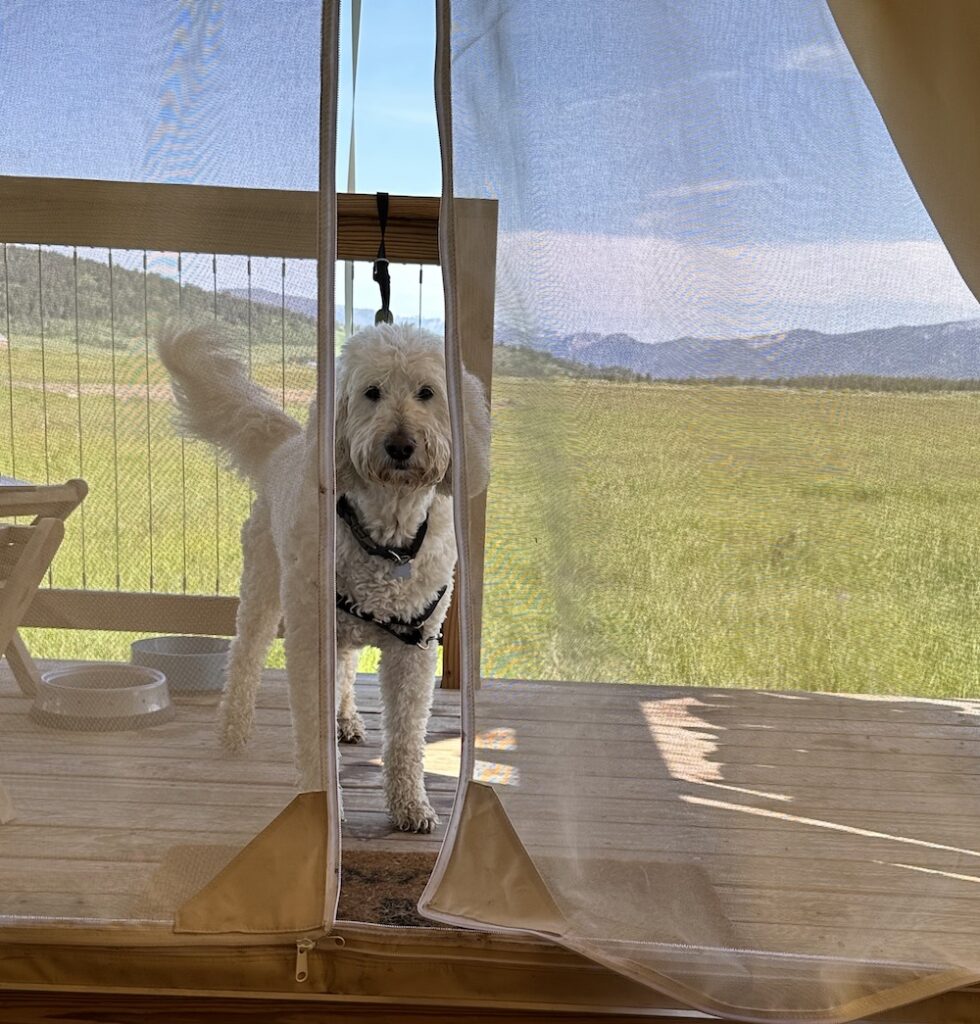
The ladies got a full eight hours of sleep in a real bed while I literally tended the home fires (in a potbelly stove) to keep the luxe tent villa toasty. We’ve stayed at four different types of campsites so far, each with its own miniature cultures and denizens. This may need to be a separate post, but I will note here that if I were an anthropologist of ethnographer I’d just set up camp and never leave. From glamptown we moved the show into more familiar territory, a trusty KOA Holiday less than 1.5 miles away — shortest transit yet.
And that pretty much defined the day. I hadn’t scheduled today off from sightseeing, but it happened anyway. The spreadsheet is not our master, apparently. But the truth is that this stretch is all centered on Yellowstone and Teton national parks with little definitively scheduled. We’ll be staying at four different places, but the long hauls between sites are finished. And that feels good.
We’ve got a cozy little trailer space between trees and, if the weather holds, we’ll fire up a projected outdoor movie at some point. But for now, a very unusual bedtime before 10pm. It’ll still be light out, but I’m just that tired.
Next up: hardcore park day, the ladies say.
Day Nine – Putting the Amp in Glamping
Today was mostly our run to Yellowstone, which, with the CB, almost naturally turned into a karaoke medley of 1970s and 80s truckin’ tunes. I present it to you here with apologies.
But the day began waking on the bison ranch and strolling to see the fluffy cows. I remembered the owner telling me that if a bison’s tail was straight up it was about to pee or kick my ass, so I tread cautiously. There was a five-day-old calf trotting around and numerous pregnant mamas, but no overnight births. Zeus the massive bull eyed me suspiciously. One of the many upsides of camping at a ranch is that the free range chickens had plucked almost all the bug splat off my car.
With no real camper hookups — though I did charge the car by running a very long line into the owner’s house to the laundry machine 240v outlet — we skeedaddled to the only local destination, Symes Hot Springs Hotel and Mineral Bath, for a dunk, shower, and breakfast. This place was legit in a cowboys-once-bathed-here and yep-sure-smells-like-sulfur way. Not sure the ladies loved that. But it was authentic and plenty hot (108°).
We shot south and east on Highway 93 that our road-based audio tour told us has been called the most dangerous road in America. Traveling a maximum of 50 MPH in my jalopy rig I didn’t experience danger, though there certainly was unforeseen anxiety as the range calculation just seemed off to me. And indeed it was. We weren’t going to make it to West Yellowstone with a net elevation ascent of 2000’. So … we outright stole electrons from the only RV park we passed. Just pulled up, hooked in, slurped some juice, left a note for the site owner, and got back on the road. I’m getting good at this.
So yeah, we did some roadtrip karaoke, an homage to the bizarre sub-genre of CB and trucking-based country of decades past. Please enjoy our renditions of Convoy, Eastbound and Down, I’ve Been Everywhere, and Roll On.
The day’s payoff was our destination: Under Canvas West Yellowstone, an actual glamping site. I reserved a single night as a reward for the girls putting up with the past ten days of my ridiculousness. It was actually camping in the sense of no power, no Internet, no food allowed (to keep bears from snooping) and heat from a fire, but it was also luxury with real beds, a shower, a flushing toilet, and lots of upscale amenities. A lovely transition to the third and last phase of this trip in Yellowstone and Grand Teton.
Day Eight – Rewilding
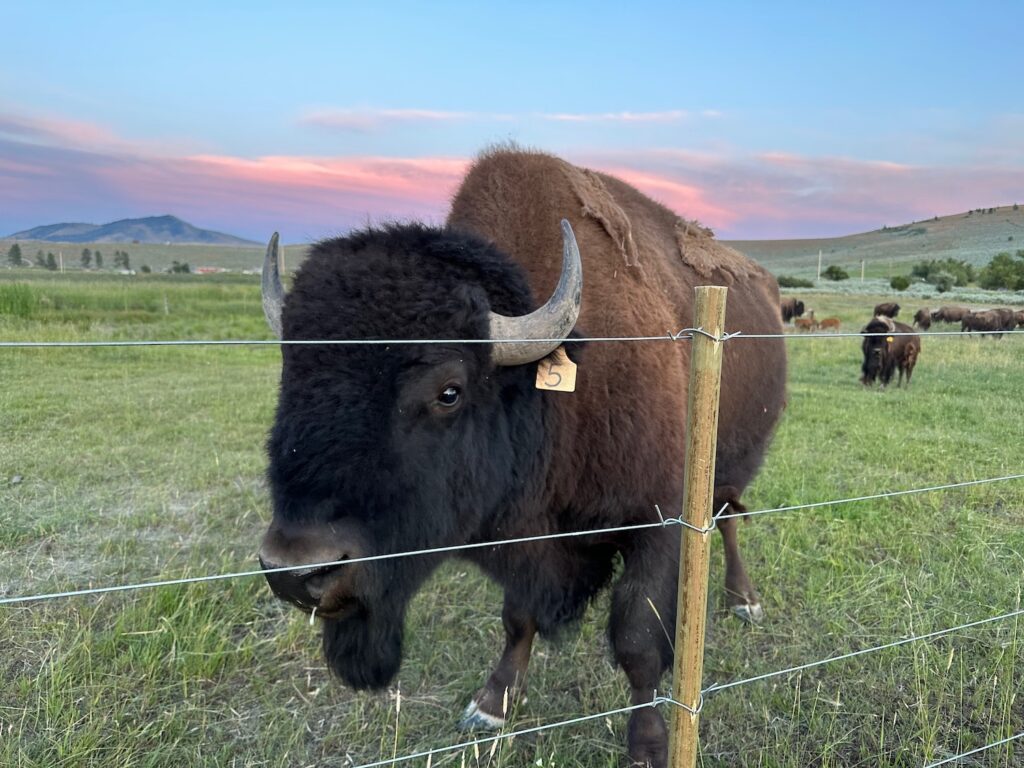
More photos here.
Mike Tyson supposedly once said “Everyone has a plan until they get punched in the mouth.” This describes today except that I’ve known this left hook was coming from the early days of planning this trip. In fact, it’s in the itinerary grid as DANGER. More on that after the fun stuff.
Having explored Glacier on foot, horseback and by vehicle, we took a boat cruise on St. Mary Lake this morning. Water placid, sun shining, campers happy. The lake itself is glacially-carved and fed by five current, though radically-diminished glaciers. It’s dark, deep, ultra-cold scary water like many alpine lakes. The boat captain told a story of park service divers exploring the depths a decade ago where they found a vast cave system and 6’ long lake trout of indeterminate age but likely from when the park service thought it a good idea to stock the lake with non-native species back in the 30s.
On one side the scarred hillside from the Reynolds Peak Fire 8 years ago with life of course returning as life does. The other side verdant but dealing with a nasty invasive beetle and worm infestation — the only real cure for which (outside of pesticides which aren’t used because of secondary ecological effects) is, ironically, wildfire. While no one wishes for it, fire can mean life here.
A close (but slow) approach to Wild Goose Island at eye level was a last little high five to Stanley Kubrick and his masterpiece. (Though in truth the love here goes to the The Shining second unit, as this was the part of Kubrick’s life where he never left England.)
Saw a mama moose frolicking in the shallows as her cub watched from shore; chased a waterfall where neither of my charges fell in, though I had video rolling in case; and finally got to see obvious geological evidence of Glacier’s weird overthrust fault tectonics. This was our goodbye to the park, one that I will absolutely return to now that I (sorta) know what I’m doing there.
On one of the motorhome trips from my youth, I distinctly recall breaking down. (Not personally, though I am sure that happened as well, but the rig itself.) I was reminded of this because my mom solved the mystery of why Big Timber was circled on the old “three week trip” map. That’s where our RV died. Why did it die? It ran out of gas! Apparently there were two tanks on that beast and the switch to transfer to the second tank malfunctioned. We had to be towed into Big Timber and (I am told) my mother ran the shop cash register while the sole mechanic tried to fix our RV.
I find it funny that we ran out of gas because my current trip is all about wondering if we have enough juice to make it to the next juice station. This is one aspect of my father’s travels I’d rather not repeat.
Today was by far the riskiest run of the trip: Glacier National Park to Hot Springs, Montana (halfway to Yellowstone). The challenge is purely due to lack of charging infrastructure. And before you but-gas-power-exists! me recall that gas stations inside national parks are incredibly rare (and non-existent at Glacier — though, interestingly, there are level 2 chargers available at certain lodges inside the park for paying guests). We have been mostly overnight charging from the campground RV power hookups — which is technically not allowed — and we did that again last night, but even with a full battery this particular run is just outside the range I have come to expect. Add in a crossing of the continental divide and a 2000’ downhill net elevation change (plus of course the several thousands pounds of towage) and I have an interesting math problem on my hands. Can it be done? Tune in tomorrow.
Nah, kidding. We made it no problem. Found an online-reservable (!) level 2 charger at a roadside tchotchke shop at the west entrance to Glacier. Pretty sure that will be the only time we will need to slow-charge while on the go. I certainly hope so.
Our campsite tonight courtesy of Harvest Hosts, basically Airbnb for RV’s. “Hosts” are ranches, farms, wineries and the like and usually only allow one RV per night. We’re at a working bison ranch in Hot Springs, Montana called Ring of Horns. No amenities, rudimentary hookups, but after the chaos of national park campgrounds the solitude and sheer novelty of staying on a ranch is delightful. We fed these majestic beasts right when we arrived after they stampeded (behind an electric fence) over to us. Best welcome of the trip.
Day Seven – Riding-To-The-Sun
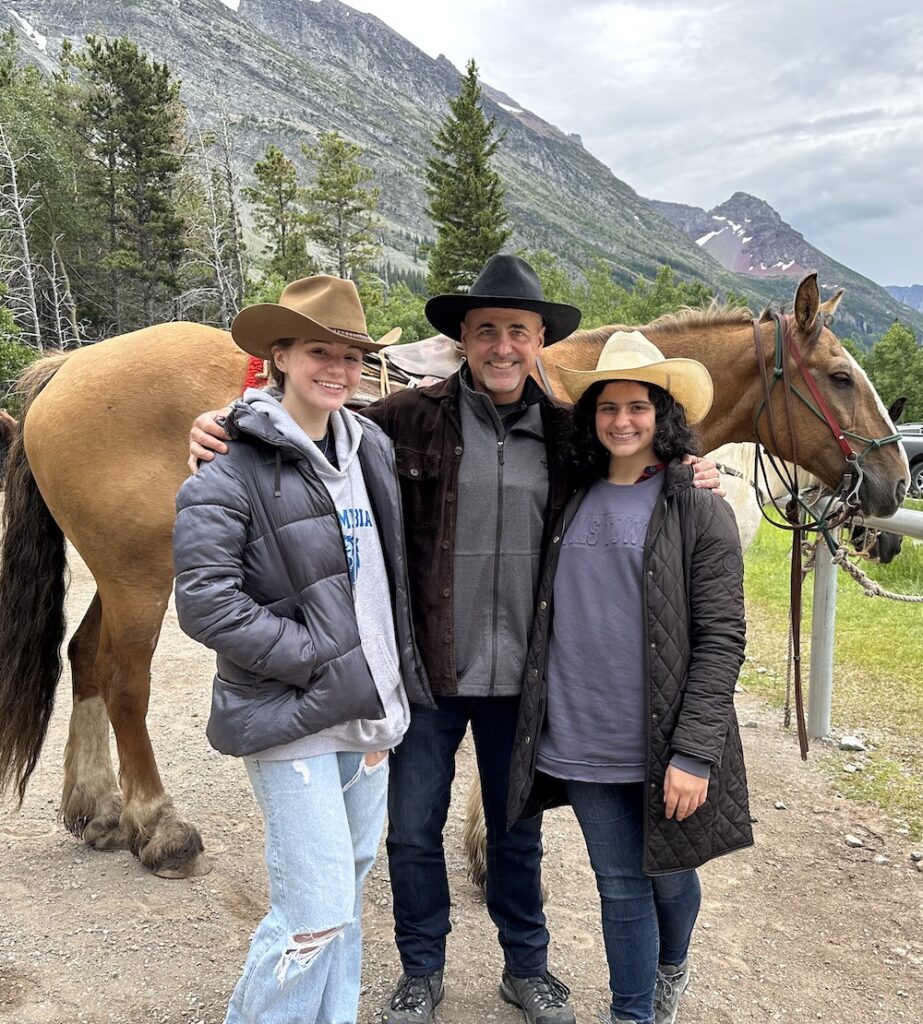
More photos here.
Arrived on the outskirts of Glacier National Park through a most bizarre thunderstorm as the sun set. The horizon is so broad here that one half of the sky was a crazy-slow setting sun backlighting the mountains of the park while the other half of the sky was a sparking supercell strobe light. As we weaved north we’d alternate between sheeting rain and total dryness. I appreciate this drama seemingly each time we arrive at a national park. The dissonance of the orchestra before the show begins.
My father was a lifelong owner and competitive rider of horses. He just loved everything about the beasts. (I vaguely recall a family vacation to a dude ranch.) When he passed each of us took some of his riding gear, though none of us kids are horse people per se. But today we were! Each of us wearing one of my dad’s hats, the girls and I took a two-hour walk/trot through the Many Glaciers section of the park. It was a perfect first activity, ambling easily through a less-visited area of lakes and wildlife — including a baby moose. (Watch out for mama.)
From there, the centerpiece: Going-To-The-Sun Road, the 50 mile east-west scenic drive that goes up and over the continental divide. As a long time Kubrick devotee and lover of The Shining I had to make this drive. You’ll instantly recognize the opening scene flying low over the lake as Jack heads up to the Overlook for his job interview. This marks my last visit to non-soundstage shooting locations/inspirations for this film: Stanley, Ahwahnee, Timberline, now Going-To-The-Sun. (Oh and for the none of you interested in RV-based horror, I got you covered.)
Movie nerding aside, the views from this road were some of the most stunning I’ve ever driven (for the day unhitched, which brings its own sense of wild freedom). The only comparison I can make is Trail Ridge Road in Rocky Mountain National Park, though even that falls short of this experience. I’ve been to quite a few national parks and I’d easily put this ride and its turnouts in the top five things to do.
Staying multiple nights here provided us the crazy luxury of not hastily packing up and rolling out, so we had a great late lunch at a local diner/pie parlor, did the trip’s first loads of laundry, and generally tidied our rolling home. It was delightfully off-itinerary. We ended the day with some campfire pizza, a visit to the only national park astronomy observatory solely for visitor education (the park and its Canadian sister comprise one of a handful of International Dark Sky sites), and, naturally, a viewing of The Shining.
I wish we could stay here forever … and ever …
Day Six – Fossiliferous
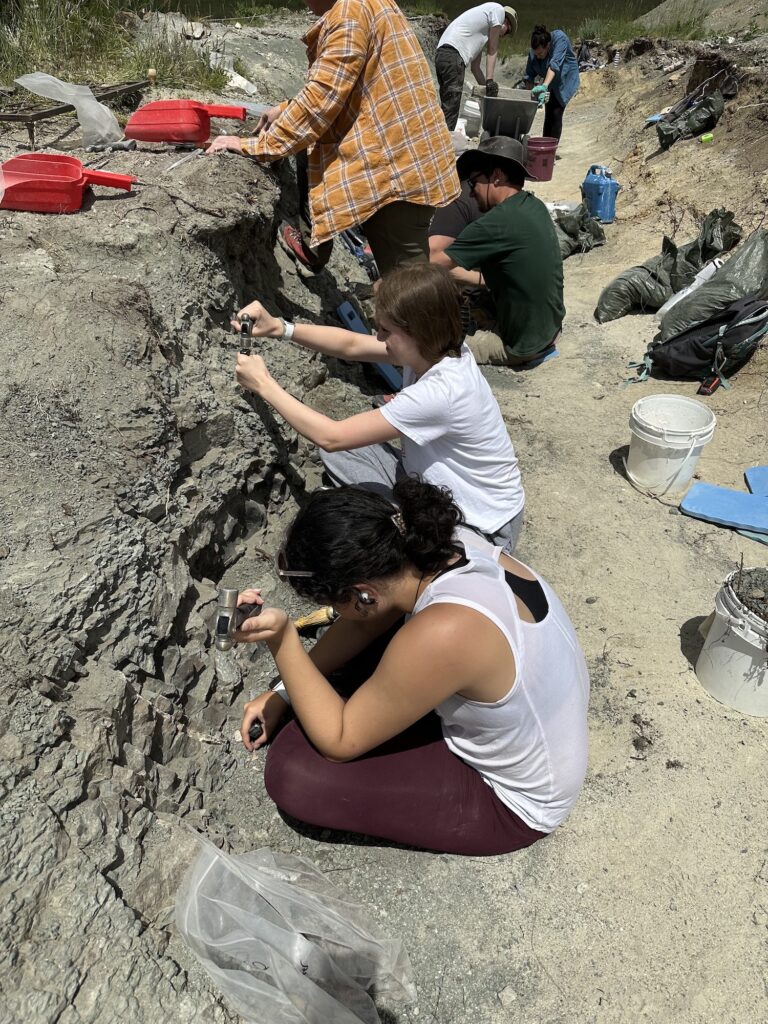
Coldest morning yet, as we approach the northernmost reaches of the lower 48.
This is the Year of the Dinosaur for me and with so many of these fantastic beasts once living (and dying and turning to stone) all throughout the American West, we’re making a bunch of stops to see them. But today we actually went out with a bunch of paleontologists to dig for fossils.
But first we had to figure out what to do with Owen the dog while we traipsed around the backcountry. Choteau, Montana (where we were camped) is small. Bynum, Montana where the fossil expedition departed is even smaller, comprising a grand total of four buildings (but the highest percentage of paleontologists per capita). Still, we found a pet sitter and called her … only to find out that she was fully booked. She suggested we call a local veterinarian — of which there were four because, being rural, there are a lot of animals to take care of (including the big, livestocky ones). First vet we called happily agreed to watch our doggo for the full day. Problem solved.
The dinosaur dig was our own version of (non-submersible) adventure tourism. The real deal in every way. We headed out with two scientists, two volunteers, and an intern from the Montana Dinosaur Center to dig into 75 million-year-old shale called “The Graveyard” in the Two Medicine Formation. On private property (with permission to dig from the owner) but also being mindful of fossil poachers, we were instructed to shut off location data for our photos and not to take post photos of identifiable landforms. We positioned our transport van ready to depart the site hastily should any bears pop up (not kidding) and we set to work.
Sweeping and chiseling we were each assigned one square meter of a predefined grid and instructed to look for certain telltale shapes, striations, colors, and “stickiness” — the latter being a rock’s ability to soak up water because of the porousness of fossilized bone compared to sedimentary rock. We immediately found fragments and eventually uncovered vertebrae, a toe, at least one tooth, and tons of bone fragments almost all from hadrosaurs (which you may know as “duck-billed” dinosaurs). It was tedium punctuated with thrills.
I did have to explain to my daughter the difference between excavation and demolition as she indelicately hammered away at the rock face, but she eventually got it and, with her cousin, was even enlisted to help make plaster jackets for the larger fossils and to precisely map the location of the major finds with road surveying equipment.
I learned a ton. For example, I am now pretty sure my daughter and niece will not become paleontologists, geologists, or stone sculptors. But they had fun too. It’s always a pleasure to be around people who both love what they do, know a ton about it, and want to tell you about it. An A+ day even though (or perhaps because) we returned hot, exhausted, and covered in dirt.
Speaking of dirt, the trailer is an utter sty of clothing, dog stuff, and gear. I planned no downtime for tidying up, naturally.
As far as powering the electric vehicle, we are now far beyond Level 3 chargers in-range. Nothing left now but ingenuity and possibly a well-timed lightning strike, Frankenstein-brought-to-life-like.
But tomorrow … we ride!
Day Five – Your Mileage May Vary
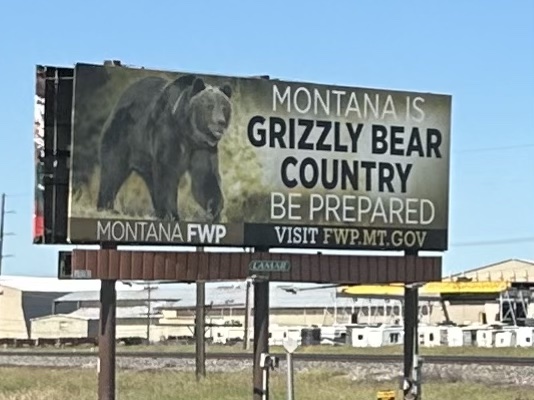
Longest run of the trip. An experienced RV’er friend who I trust completely told me not to overdo mileage per day and to try not to pull into campsites after dark. I’ve done neither of these things today. This is what I refer to as the high-risk, high-reward segment of the trip. Eventually we’ll arrive at our nation’s ceiling — Glacier National Park — with a few stops along the way.
I don’t blame the girls for diving into their devices for this haul, though they are missing some great Montana scenery. (It’s my first time as an adult in this state and it’s gorgeous, a vaster Colorado in some ways.) And yet, their attitude has been remarkably upbeat and accommodating, especially for teen girls. This journey can be a slog (punctuated by lots of incredible moments, no doubt) so A+ to the ladies. For now. The wheels may come off the bus yet.
We started at the Little Bighorn Battlefield National Monument 147 years almost to the day that Custer and his men made their last stand. The US military was, of course, roundly defeated by the Lakota and allies — a somewhat satisfying retribution for Sand Creek — but the battle really was the beginning of a fast end to any real freedom the Plains Indians had hoped for. It’s interesting to see how interpretation at the actual site now works against the sort of Custer hagiography that generations of Americans came to understand as a bedrock example of manifest destiny. Little Bighorn doesn’t vilify the American dead, but it no longer presents the story as a valiant stand against savagery in an unfortunately lopsided contest. The Lakota fought for their lands and freedom; Custer made strategic then tactical errors that got most of the 7th Cavalry Regiment killed. That’s really it.
On my father’s map of our motorhome trip back in 1978 (my sis and I now believe this was the date) there’s a single location circled: Big Timber, Montana — which we passed through today. My thought had been that he marked this town because he took a great photo there which hung in our home for decades. While the town is scenic, nestled at the foot of the Crazy Mountains, this theory turned out to be wrong. I have no idea why my father marked this town on the map, but I’m glad we visited.
Swung through a surprisingly lovely Bozeman primarily to visit the Museum of the Rockies, which I learned is run by Montana State University. Of course I was there for the dinosaurs, but the entire place was exceptional — especially for a university museum. Unsurprisingly they take paleontology seriously in Montana. The exhibit design was top-notch and, given its proximity to the Hell Creek Formation, the place was swarming with Triceratops and its ilk. Plus a real (not replica) T. Rex. Take that, Field Museum!
Lest you think this trip is nothing but good times, I’ll note that there are lots of challenges we’re simply dealing with, ignoring outright, or secretly seething about. The RV battery does not hold a charge so our fridge food slowly goes bad during the day, the toilet smells like death, and of course campground connectivity is almost universally awful. Also, a piece of Big Sky Country seemingly fell on us today so there’s a bullet-sized hole in our windshield. And while these are all small things, it does please me to know that the me of five years ago probably couldn’t have handled it. I’m just enough of a kid to want to undertake a trip like this, just mature enough not to lose my shit doing so. That’s worth something.
But mostly it was driving today, so much driving. We’re camped in Choteau, MT tonight for a special day tomorrow.
Day Four – Maybe Today Satan
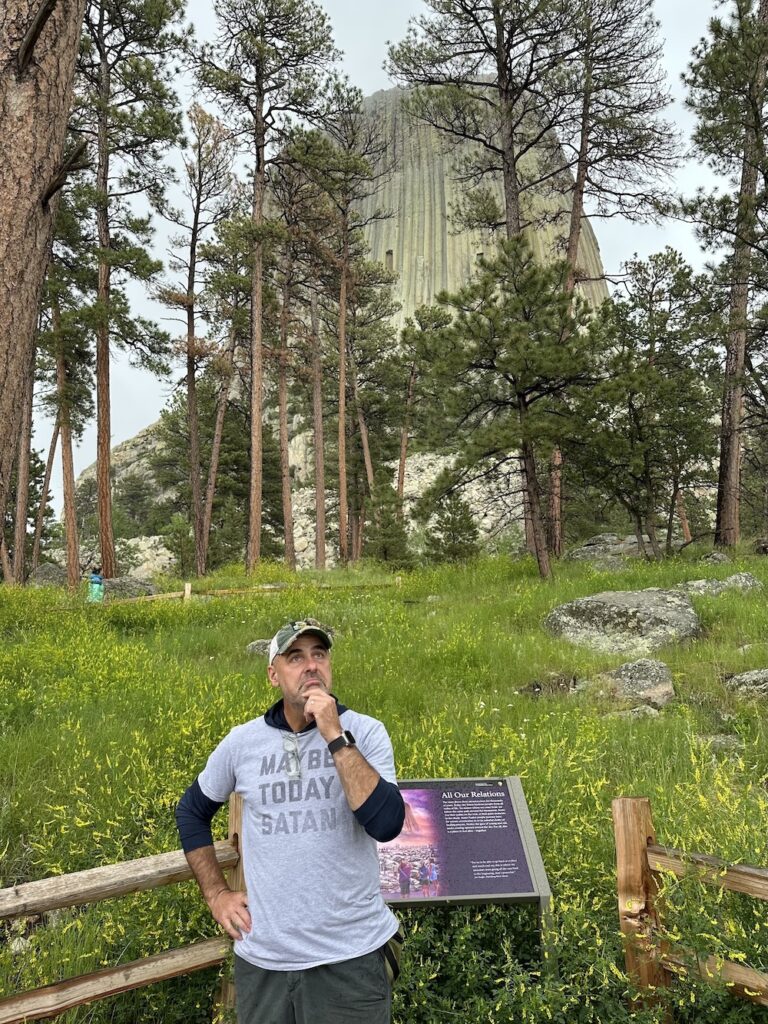
Today was both the summer solstice and, apparently, Naked Hiking Day. We celebrated neither. Indeed, we slept in a little after the trauma of arrival the night before, got in a little kampground mini golf (three times and it’s a “tradition” now) and made our way to the imposing National Monument right across the street.
The Park Service certainly runs a tight ship as we were directed to a lot at the base of Devils Tower to unhitch our trailer such that we could easily park closer to the trailhead. Unfortunately just as we set out to hike, the rain returned. We were hiding from the deluge under a rock outcrop in the sizable boulder field that skirts the tower when we heard a scream from up the trail. I peered out and saw a person crumpled on the path. Ran to her, helped her up, and saw that blood was pouring down her face. She had been running down the slick path (slicker because it was paved) to escape the rain and took a nasty spill. I dumped her water bottle over her face to clear the blood just as her husband arrived. They proceeded down, arm-in-arm. A short time later we heard ambulance sirens in the distance. Stitches required for certain, but I wouldn’t be surprised if she were concussed. We continued our hike a bit but didn’t complete the whole loop. Completely soaked but amply impressed, our close encounter with Devils Tower was over.
So, about the CB radio I have rigged up. Once my daughter, niece, and I decided to take a roadtrip in the style of my father I knew I needed to get on the citizens band. Given his not-so-secret dream of being a long haul trucker, my dad of course partook of the 1970’s infatuation with CB radios and culture. We had one in the motorhome. My dad’s handle was “Trapper” and I, naturally, was “Little Trapper”. I definitely recall having conversations with truck drivers all along the route. Good fun before the Internet. I purchased a retro model Cobra CB for this trip and let me tell you getting it hooked up was a massive pain in the ass. I had forgotten how finicking analog radio waves can be. Ultimately — with the help of a kind gent at Summit Radio, the only remaining CB-only shop in Denver — I was able to run a cable from the radio out the back of my car, across the hitch, and up the side of the trailer where we mounted a whip antenna. It worked in our tests. Still works, in fact, though we have yet to have a conversation with anyone. Apparently even truckers these days mostly use cell phones and EMS long ago switched to different spectrum. At best we catch snippets of chatting amongst the garble and static. It’s never quite enough to make out what’s being said exactly, just fragments crackling in and out of coherence. But fun nonetheless. Makes me think about why I went through all the hassle to get the radio working in the first place. And I think I know: I’m “listening” for my dad. Not in some paranormal ghost hunter-y way, but as a kind of analog nostalgia for who he was. I squelched the grief long ago and now I just revel in the moments of joy that the full (if intermittent) signal his memory provides.
Pulled into our waypoint campsite tonight again after dark and in pouring rain. Somehow this was a lower moment than last night for our site did not have the proper electrical connection to charge the car. I slopped all around the campsite in the dark, headlamp on, creep factor high — looking for another site I could surreptitiously occupy for the night. Found one and hooked in, but not after inventing some fabulous new swear words. Lesson learned though: sometimes you share hookups with the RV next door. Which shouldn’t be a problem normally, but tonight’s hassle is my punishment for sneaking electrons to charge my car. Worth it.
Day Three – The Good, The Badlands, and The Ugly
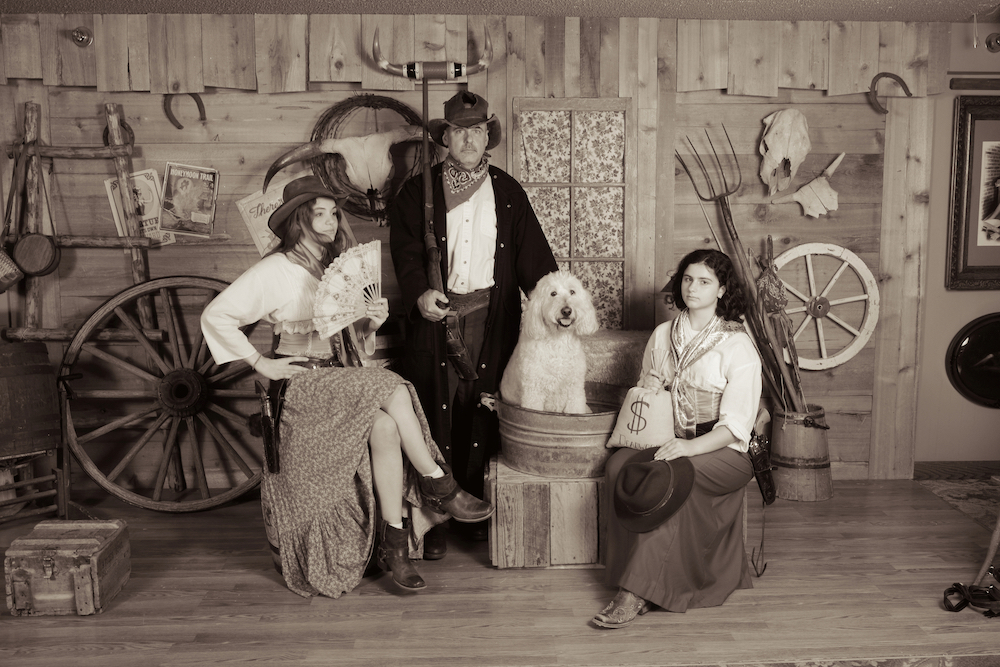
A long day of incredible sights, ending with a Old Testament-grade thunderstorm as we pulled into our night’s campsite. But that’s getting ahead of things.
Today was about the Badlands, those crazy geological formations (with a lowercase ‘b’) all over world basically tell living things to make a detour. And yet, life, uh, finds a way. As we found ours up, down, and around the crags and pinnacles. Being varying levels of dinosaur nerds we searched for evidence of the KT boundary, but as our Badlands formed right after the extinction event (geologically speaking) it would have been right at ground level if visible at all. Which it wasn’t. Sad dino nerds. But wow is that place beautiful, looking not so much like a landscape as a matte painting with such severe contrasts of light and dark. But color too, in places, which is delightful. All nestled cozily in grasslands stretching to the horizon, as our Great Plains did before we carved it all into squares for agribusiness.
Leaving the Badlands is where we finally picked up my father’s late-1970’s motorhome trail on I-90. His route, you might recall, was the catalyst for this whole ridiculous odyssey, so intercepting the path of yore was meaningful. And we did so at Wall Drug, the crazy nearly century-old roadside pharmacy turned Americana theme park, which he loved. As my daughter put it, “This is like the inside of Grandpa’s head.” A compliment, to be sure, but neither places you want to overstay.
So we scooted west to Rapid City mostly to top off electrons. We hunted for a diner (no luck), high-fived/flipped off a few of the town’s tourist-bait roadside president statues, dropped in on a haunted (yeah, no) hotel, and got out. Rapidly, you might say.
Up in elevation from there to Deadwood. Where Wall Drug presents a faux old west townscape, Deadwood desperately tries to maintain itself as a time capsule of a real one. It was probably all over for the town when its last brothel was raided and closed in 1980, but that doesn’t keep the architecture from still being pretty amazing on a long stretch of main street. We took some old tyme photos, cleaned up an anxiety-poop from Owen (our dog) at the gunshot blanks being discharged for a showdown shoot-‘em-up re-enactment in the middle of the street, and left town alive (as Wild Bill, alas, did not).
Onward to Devils Tower, geological marvel and plot finale for Close Encounters of the Third Kind. Devils Tower was one of a few early anchor destinations that I, a sci-fi geek, planned the trip around. But the skies opened up as we approached. Lightning in the Black Hills is sublime and terrifying, providing possibly the spookiest first viewing of the tower ever. (See the Instagram post for this day and prepare to enter the Upside-Down.) Hooking up a 50 amp electrical connection while rain dumped down and lighting bolts sliced up the sky was a low point. But then, I thought, at least I didn’t shit myself in terror like Owen did. Positive thinking, people!
Collapsed immediately.
Day Two – Into The Black Hills
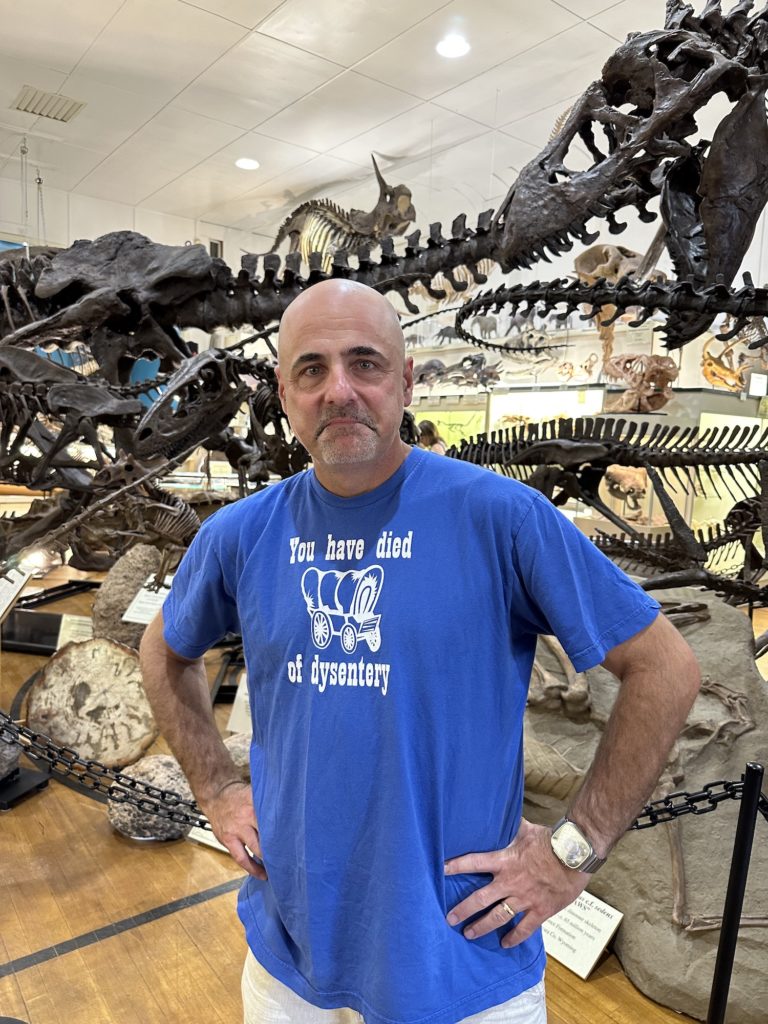
Day two, first morning at a campground. Not the most exciting overnight beyond sweating ourselves to sleep and waking up freezing. We possess the ability to thermally regulate, just not a ton of sense of experience to execute. But that’s the thing: we’re learning bit by bit, muttered curse by muttered curse, unexpected joy by unexpected joy. We’ll be experts in what we know and comfortable in the naïveté of what we don’t by July 4, I’d wager.
Leaving Wyoming we crossed into South Dakota and the towns leading into the Black Hills. I was glad to be back after recently finishing Dan Simmons’ masterful The Black Hills and subsequently having no desire to trot over to Mount Rushmore. Hit Custer on the way to our first real destination in Hill City, the Museum of the Black Hills Institute. Known primarily for its role in the discovery of Sue the T. Rex (now at Chicago’s Field Museum) it’s a small affair with a truly exceptional collection. Two laps of the whole thing and the teens were still enthralled. We’ll see if that lasts through our actual fossil dig in a few days …
For something completely different we visited the Cosmos Mystery Area, a surprisingly fun bunk science sideshow where buildings erected at weird angles on a hillside show “evidence” of cosmological “hot spots” where gravity is wonky. It’s not. The whole experience is your inner ear data fighting with your eyes’ visual data. Of course it knocks you off kilter, but it isn’t a mystery. I’d do it again, though. Always up to humor a carnival barker.
From there we took a short jaunt onto the other planet that’s known Badlands National Park. Just a taste as we were heading to our campground. The Badlands gets our full attention tomorrow — as does Deadwood and finally Devil’s Tower tomorrow night.
A note on KOA Kampgrounds, our second tonight. There’s a massive difference between Journey tier sites (basically camps only as waypoints) and Holiday tier sites (amenity-laden destinations). The ladies prefer the latter. I just need to sleep.
Oh and another campsite observation. KOA sites all have ample bathroom and shower facilities, but I find that the toilets are only used by people who don’t want to lay waste in their $200,000 home-on-wheels. What I’m saying is that campsite-provided indoor plumbing witnesses atrocity.
And goodnight!













